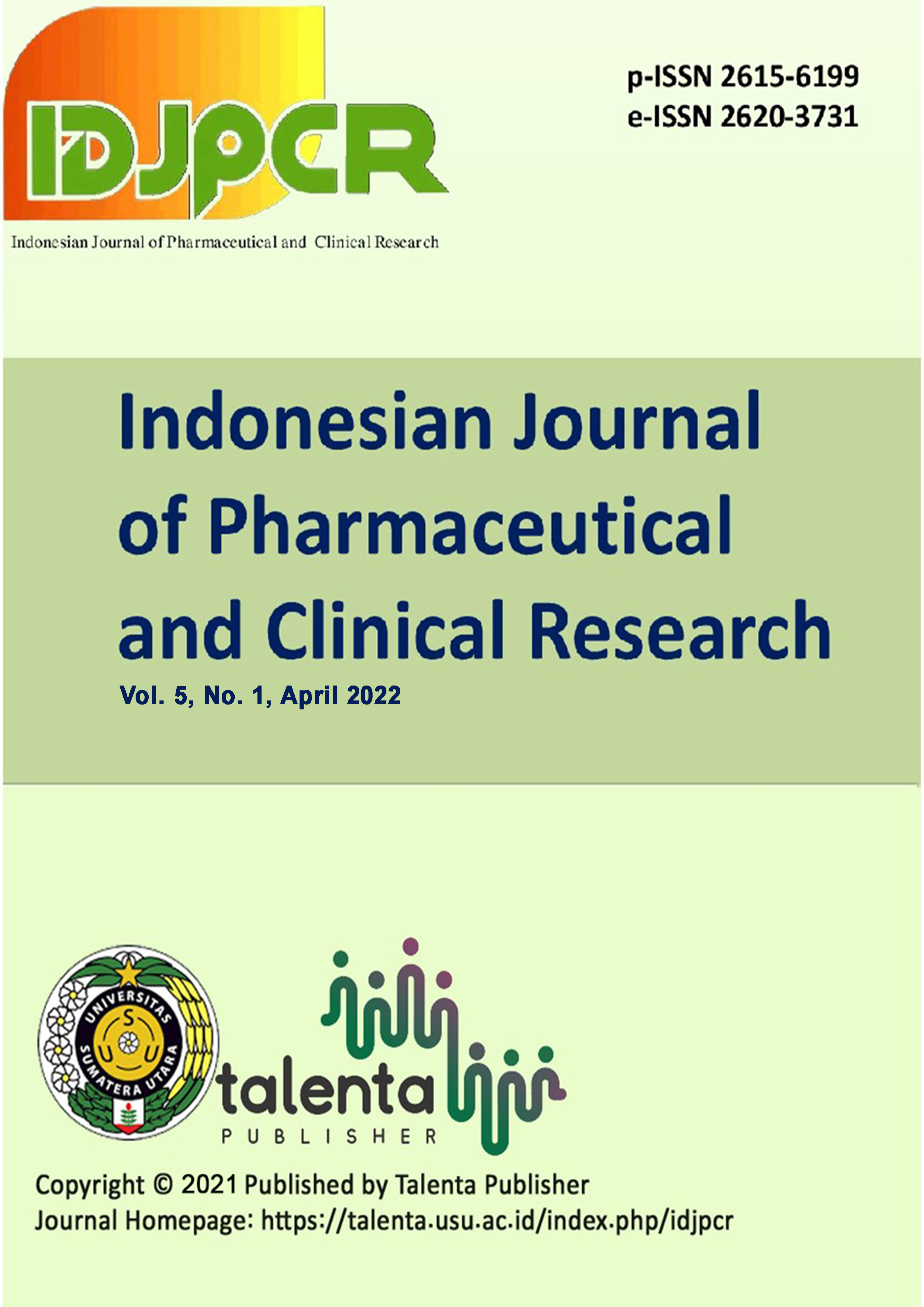Formulation and Evaluation of Cream Turmeric Extract Preparations from Turmeric Rhizomes (Curcuma domestica Val.)
DOI:
https://doi.org/10.32734/idjpcr.v5i1.6479Keywords:
turmeric, cream, evaluation of cream, turmeric extractAbstract
The use of plants as a method of herbal treatment is a step that is currently being developed by many researchers to produce effective and minimal side effects. Turmeric is one of the most widely used cooking spices by the people of Indonesia. The main ingredients possessed by turmeric include curcumin (77%), demethoxy (17%) and bisdemethoxy (3%). One of the pharmaceutical preparations with a topical delivery system is a cream preparation which is a semi-solid dosage form, containing one or more drug ingredients dissolved or dispersed in an appropriate base material. Turmeric can be formulated in various preparations, one of which is a cream dosage form. The advantage of using cream preparations is that they are practical, easy to wash and clean. The purpose of this study was to formulate turmeric extract in a cream preparation. The results of the evaluation test showed that the formula produced a cream with a yellow-orange color, a characteristic odor of turmeric, and a preparation with a semisolid cream texture, had good homogeneity, good dispersing ability, the pH of the preparation was 5.84; 6.32; 6.24; 5,94;5,94 and the type of emulsion is O/W (Oil in Water).
Downloads
References
Utari, K.D.P., Unique. I.G.A.N., Aryani. N.W.G., Arisanti. C.I.S dan Samirana, P.O. (2019). Optimasi Formula Krim Ekstrak Rimpang Kunyit (Curcuma domestica) dengan Variasi Konsentrasi Setil Alkohol sebagai Agen Pengental. Jurnal Farmasi Udayana. 7(2): 40 – 44.
Epelbaum, R., Schaffer, M., and Vizel, B. (2010). Phase II study of kurkumin and gemcitabine in patients with advanced pancreatic cancer. Nutrition and Cancer. 8. Halaman 1137–1141.
Mandal, V., Mohan, Y., and Hemalatha, S. (2007). Microwave assisted extraction of kurkumin by sample–solvent dual heating mechanism using Taguchi L9 orthogonal design. Journal of Pharmaceutical and Biomedical Analysis. 322 – 327
Verma, A., Singh, S., Kaur, R., Jain, U.K. 2013. Topical Gels as Drug Delivery Systems: A Review. International Journal of Pharmaceutical Sciences Review and Research. 23(2): 374-375.
Masaki H. (2010). Role of antioxidants in the skin: Anti-aging effects. J Derm Sci. 58: 85–90.
Harborne, J.B. 1987. Metode Fitokimia: Penuntun Cara Modern Menganalisis Tumbuhan. Bandung: Penerbit ITB.
Ansel, H.C. (1989). Pengantar Bentuk Sediaan Farmasi, diterjemahkan oleh Farida Ibrahim, Asmanizar, Iis Aisyah, Edisi keempat. Halaman 255-271, 607-608, 700. Jakarta, UI Pres.
Wasitaatmadja. (1997). Penuntun Kosmetik Medik. Penerbit Universitas Indonesia: Jakarta. 21 – 25
Alfred, M., James, S dan Arthur, C. (1993). Farmasi Fisik, Dasar-dasar Kimia Fisik dalam Ilmu Farmasetik. Jilid III. (Yoshita). Jakarta: UI Press
Ulaen, S.P.J., Banne, Y.S., dan Ririn, A. 2012. Pembuatan Salep Anti Jerawat dari Ekstrak Rimpang Temulawak (Curcuma xanthoriza Roxb.). Jurnal Ilmiah Farmasi. 3 (20): 45–49.
Depkes R.I. (2000). Parameter Standar Umum Ekstrak Tumbuhan Obat. Cetakan Pertama. Jakarta. Ditjen POM. Halaman 17, 31-32
World Health Organization. (2011). Quality Control Methods for Medicinal Plant Material. Ganeva: WHO. Halaman 26 – 27.
Rowe, R.C., Sheskey, P.J. and Quinn, M. E. (2009). Handbook of Pharmaceutical Excipients Sixth Edition. Pharmaceutical Press.
Juwita, A. P., Yamlean P., Edy H. J. 2013. Formulasi Krim Ekstrak Etanol Daun Lamun (Syringodium isoetifolium). Jurnal Ilmiah Farmasi. Universitas Sam Ratulangi. 10.
Safitri, U, H., Nawangsih, E, F., Noviyanti, N, D., Nur’aino, F., Apriliani, D., dan Haniastuti, T. (2016). Studi in vivo ekstrak etanol ciplukan (Physalis angulate) dalam meningkatkan apoptosis sel kanker lidah. Majalah Kedokteran Indonesia. 2(3): 112 – 114. DOI http://dx.doi.org/10.22146/majkedgiind.10744
Downloads
Published
How to Cite
Issue
Section
License
Copyright (c) 2022 Indonesian Journal of Pharmaceutical and Clinical Research

This work is licensed under a Creative Commons Attribution-ShareAlike 4.0 International License.
The Authors submitting a manuscript do so on the understanding that if accepted for publication, copyright of the article shall be assigned to Indonesian Journal of Pharmaceutical and Clinical Research (IDJPCR) and Faculty of Pharmacy as well as TALENTA Publisher Universitas Sumatera Utara as publisher of the journal.
Copyright encompasses exclusive rights to reproduce and deliver the article in all form and media. The reproduction of any part of this journal, its storage in databases and its transmission by any form or media, will be allowed only with a written permission from Indonesian Journal of Pharmaceutical and Clinical Research (IDJPCR).
The Copyright Transfer Form can be downloaded here.
The copyright form should be signed originally and sent to the Editorial Office in the form of original mail or scanned document.









